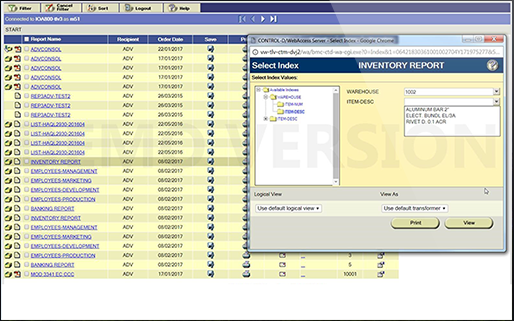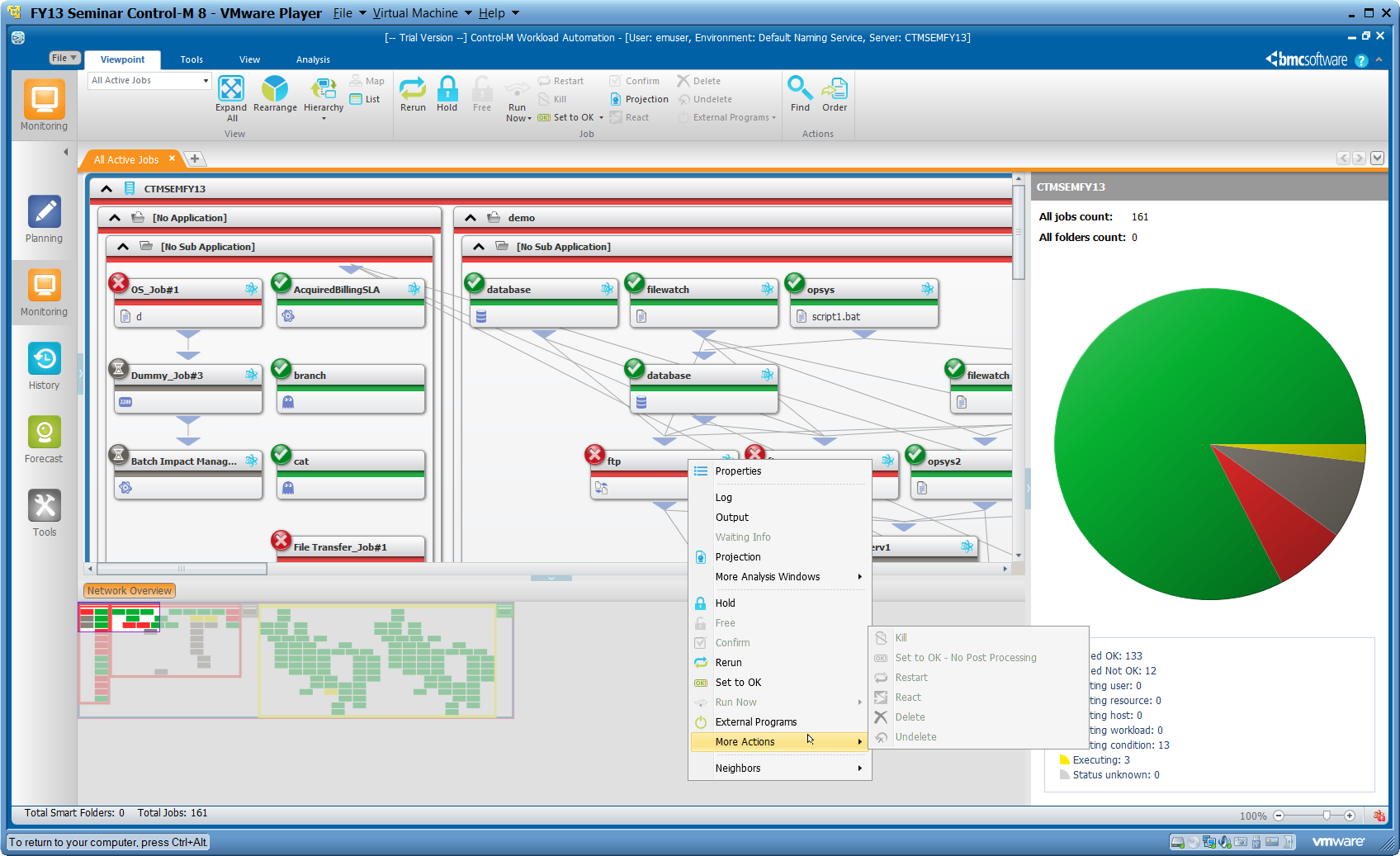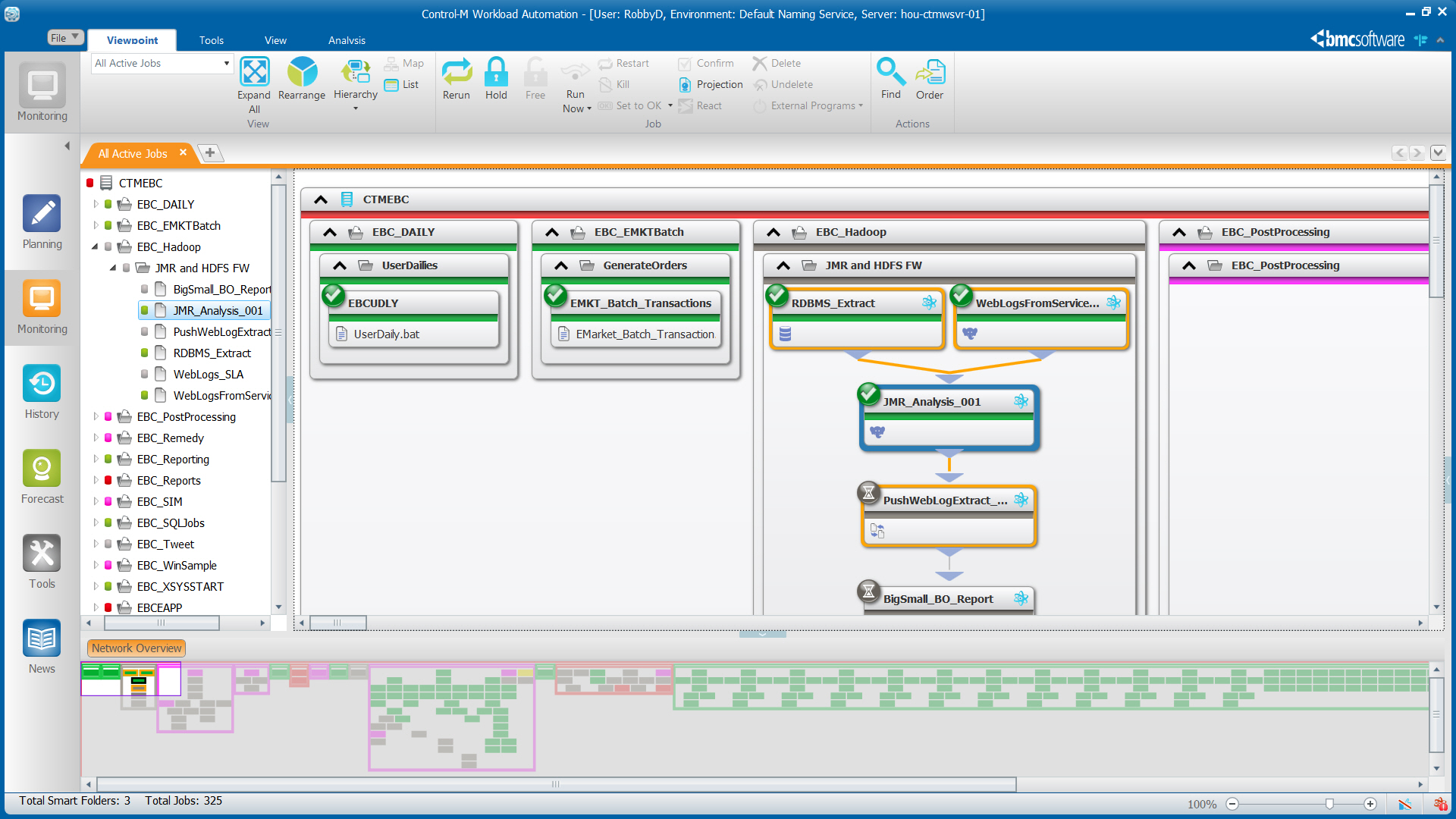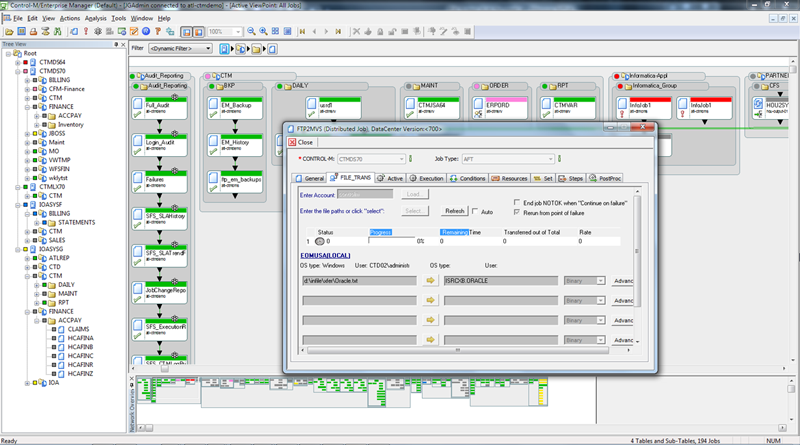BMC Control-M Scheduler Enterprise Scheduler - Workload Automation
BMC Control-M is a great product that has been around for years. It is both mature and cutting edge. It has been around for a log time but also keeps up with the most recent trends.
Here is a sample screenshot of what you get with Control-M. If you are a Tidal user and are familiar with the Tidal GUI, seeing this should get you excited. You know what I'm talking about.
Job Scheduling with Control-M
BMC Control-M is a job scheduler. Essentially, it is a tool to manage batch jobs. It is produced by BMC Software. The main task it is used for is scheduling and managing jobs. It does much more than that though. At a basic level, you could think of it as a much more complicated version of cron. You can tell it to run arbitrary tasks on a defined schedule. The difference is that it can run these tasks accross mutiple different systems all while being controlled from a centralized server. It also gives you a nice GUI to manage these tasks. This also gives you visibility which is important when dealing with complicated, interconnected systems.

Originally, when it was first created, Control M was designed to work with IBM mainframes. It now supports a huge number of platforms. These include Windows, Unix, Linux, and OpenVMS.
Control-M is a job scheduler from BMC software. Its primary purpose is to schedule batch jobs. It excels at delivering jobs on time, consistently. It is sold as a tool that is able to help with the automation and scheduling of a diverse range of tasks including anything from driving supply chains to processing company payroll information.
Visibility is important. It is critical to have a view of an entire system and how each component interconnects. BMC software have gone through great lengths to ensure that Control-M provides visibility and insight into the systems and jobs that it controls.
Reliability is of utmost importance. No system, no matter how well it performs or what features it provides is worth much if it can’t work reliably. In this regard, BMC has you covered. They have made reliability one of their primary goals when designing, building, and maintaining the Control-M scheduler. This is one area where this product differs from Tidal Enterprise Scheduler. It has been said that TES has suffered from numerous bugs and suffered huge reliability issues since the release of the current version ( V. 6 ). If reliability is important to you, Control-M will fill this need where Tidal has fallen short.
SLA performance is a top feature. Being able to complete defined tasks within the constraints of defined parameters is what BMC builds software for.
Single-point automation is another focus of this product. The entire point of the product is to automate the scheduling of jobs and tasks while making everything easy to manage. It isn’t enough to just automate but the automation needs to be easy to manage from one single place. This is what Control-M brings to the table.
The management of job scheduling is what makes up the core functionality of this system. It provides this functionality across many disparate systems. Support is provided for a huge number of different environments and platforms. These platforms include Linux, Unix, Windows, and even OpenVMS. It supports more than this though. It also supports OS/MVS and not as an afterthought but as a system that it was originally designed for. Control-M was originally built for IBM mainframe systems.
The amazing, intuitive graphical user interface will increase the productivity of anyone working with the product. You might be inclined to ignore your instincts when choosing a product. You might think that you shouldn’t choose a piece of software because of the GUI or because of how nice it looks. You would be partially right. A pretty GUI won’t give you any real ROI but a truly good GUI will provide more than just something pretty. The Control-M GUI gives you increased control and allows standard tasks to be performed quickly and efficiently. This saves time and effort for everyone who needs to work with the system. If you don’t have a good interface to control the system, it doesn’t matter how good it is under the hood. An example of this would be TES. If you spend enough time working with TES, you will realize how much a bad GUI can slow you down. You will come to appreciate just how critical a usable GUI is. Control-M provides a great GUI that allows work to be done efficiently and with ease so people can focus on what is important.
When you use Control-M you will be fully prepared to automate batch processes. You will have in your hands a powerful tool for automation that spans across multiple different platforms and operating systems.
Reliability is a top priority even when processing large complicated tasks. This system will help you ensure that complex workflows are submitted to be processed and that they are done correctly and and accurately. This is all while ensuring that processes are processed on time and according to whatever complex schedule you can come up with.
When critical issues arise, they can be addressed in detail. This can be done with accurate job analysis performed by a system that doesn’t know how to fail. This allows problems to be fixed before the business is impacted and usually before users even have a hint of a problem.
Managing File Transfers
BMC Control-M also supports file transfers. These are treated the same as normal jobs. They can be monitored and managed from the same centralized system. Everything is in one place. This means that transfering files doesn’t need to be messy or tedious. It can be simple and streamlined. It is also wortth mentioning that file transfers are secure ( or as secure as you make them ).
Control-M Managed File Transfer gives users a wide range of capabilities. Users are given the ability to build secure, versatile file transfers. Users are given the ability to schedule file transfers with an unparalleled level of flexibility. Once created and scheduled, these jobs can be managed as easily as any other job. Manageability is critical to maintaining a workflow. All of these tasks are performed just like any other normal batch job giving users less of a learning curve and keeping things consistent.
File transfers are combined with application job workflows to form a cohesive whole. These are managed from a single view. This improves visibility. It increases the level of control experienced. It further reduces administrative costs.
It is the goal of BMC to provide a product that will centralize and automate all file transfers regardless of type. This is to be done while simultaneously simplifying the scheduling of these jobs. File transfers will be aligned with business process flows.
Operator want to have visibility into the status of jobs and file transfer. They want this instantly, without having to take extra steps or fumble around with multiple tools. This level of visibility is provided with an excellent operational dashboard. The dashboard includes strong search capabilities to further streamline work. TCO is reduced substantially with automatic deployments. These are all run from a central interface which acts as a home base of operations.
Big Data Control-M Style
Big data is huge these days and it is only getting bigger. Many big data related tasks are geared towards batch processing. This is an area where BMC Control-M does very well. It is exactly what is needed to schedule big data tasks.

Hadoop is a huge opensource system used for processing big data. Control-M is certified to work with more than one different Hadoop implementation. It is also certified to work with the top three implementations. These include Hortonworks, Cloudera, and Map-R. If you are using Hadoop there is a good chance that you are running one of these three. If not, you should still be able to automate your Hadoop batch jobs with Control-M.
Big data is more important now than ever. Control-M is ready to take advantage of big data technologies. Hadoop is one of the biggest things to enter the scene in recent years. It is open-source software for distributed computing. It is meant to be massively scalable while remaining reliable. Companies that want to take advantage of big data are using Hadoop to do it. This is one of the tools of choice for big data analytics.
The BMC Control-M Scheduler has been certified for multiple different Hadoop implementations. These include Hortonworks, one of the largest, most popular Hadoop implementations. It also includes the other major providers, Cloudera and Map-R. The scheduler isn’t just limited to being certified for the big three implementations. It is also certified for IBM Hadoop implementations.
Most data that is processed on big data platforms is in batch form. In order to provide the most value possible, it is important to consider this and work accordingly. Managing workflows and batch jobs must be done efficiently. This is important to provide the best business value. Control-M for Hadoop is focused on giving companies the fastest, most expedient path to ROI for their big data investments.
In the realm of big data, BMC Control-M allows you to create jobs without effort. It allows you to easily collaborate on workflows. Its role is that of a powerful tool for both scheduling and managing batch jobs or batch business services. This is what most corporate and small business users are both looking for. Getting things done is made simple and intuitive. It is designed to handle operations as intuitively as possible with a straightforward drag-and-drop interface. This interface acts as a single point of control over the entire system.
Users will not need to build scripts any more for common simple tasks. This speeds up ROI and expedites time to market for services that need to be production ready. Removing manual work needed for small tasks is a huge time saver.
DevOps from Control-M
BMC Control-M supports both people and technology. This is a big theme in devops. It is good for everybody.
Control-M is great for testing. It helps to improve the efficiency of testing and debugging. This is great for everyone it isn’t just a central theme in devops.
Control-M features an API. This is actually a pretty big deal, Having an API means it is easy to automate things. If you find yourself doing the same thing repeatedly in the graphical interface, that is a big red flag that it is something that should be automated. Boring, tedios, and repetitive work shouldn’t be done by hand. It should be done with automation. This is the type of thing that machines are really good at and humans are relativly weak at.
Control-M also features a CLI. If you don’t want to waste your time poking around in a GUI this may be a welcome feature. It also tends to make automation easier which isn’t as much of an issue since it also comes with an actual API.
Control-M is a great tool for DevOps teams just as much as it is for other teams. In order to operate successfully as a DevOps team it is important to have solutions that simultaneously support people and technology at the same time. This is needed to develop high quality applications faster. It is necessary to deliver these applications in a timely manner without compromising quality.
Testing is important and current methodologies are moving towards testing earlier in the development cycle. Testing is not just being done earlier though. It is being done all throughout the life cycle. This reduces the time needed to test, speeding up time to delivery. It also increases application quality as it results in more thorough, involved testing. The developers become more involved in the process. With Control-M this process is applied to batch jobs. Users are able to treat jobs as code. Leveraging this, it can be said that the product helps to shift-left job scheduling. This goes far beyond anything you might see with other products such as Tidal Enterprise Scheduler ( TES ).
Control-M has an automation API which is exactly the type of thing DevOps users like to use. As DevOps is about automating as much as possible, this is the type of capability one would expect from a good, DevOps friendly tool. Developers are enabled to define their scripts earlier in the software lifecycle. They are able to test these scripts earlier in the cycle as well. They are given full ability to debug their scripts and software as early as possible in the software development lifecycle.
The provided CLIs as well as the APIs allow development speed to be increased. This is done by automating workflows across the whole lifecycle of an application with a rich set of tools and functions. These functions are exposed to increase developer productivity as much as possible. During the testing process, it is now possible to see a preview of the actual production workflow. This helps to streamline debugging and testing by unprecedented levels. Thanks Control-M!
Users are given the option to embed their automated workflows with other toolsets that they already use. Integration with GIT is available as well as with Jenkins. Support for specifying data using JSON is included in one form or another. Tons of other tools that are familiar and useful have been integrated for increased productivity. Thanks BMC!
Control-M as an Alternative to Tidal Enterprise Scheduler
For those that either don’t like Tidal chances are just about anything will be seen as a great alternative. If you are frustrated with TES then you might say that the greatest strength of Control-M is that it isn’t Tidal and therefore will be at least more reliable with a usable GUI. You could say that but remember there are a lot of alternative job schedulers that aren’t Tidal so this doesn’t necessarily set BMC apart. The question probably isn’t about whether or not you want an alternative as much as which alternative to choose. Here we will review some of the reasons you might choose Control-M.
Control-M Open Source Alternative
A lot of people are looking for a Control-M alternative, open source, that does everything that they need.
Control-M Open Source - Status
Some people out there might actually be wondering if Control-M is open source. They might also be wondering if there is any chance that it would be released as open source software. The answer, of course is no. The idea isn’t as crazy as it might sound. It is a valid question for someone who isn’t familiar with the product. Many other vendors do have open source software the does still bring in a profit ( often a huge profit ). More still release previously closed source software as open source. I’m not saying that it will never happen but it doesn’t seam likely, at least in the short to medium term.
BMC Software
This will be about BMC Software and its relation to Control-M.



